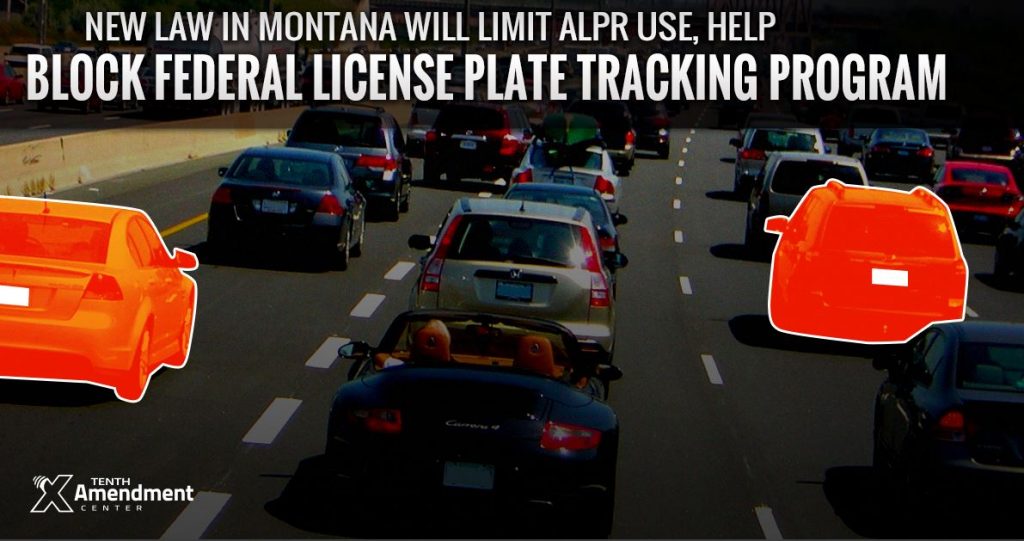On Friday, Montana Gov. Steve Bullock signed two bills into law that will increase privacy protections in the state and hinder at least two federal surveillance programs. The new laws will ban warrantless collection of data from an electronic device in most situations, and limit the use of Automated License Plate Readers (ALPRs) in the state.
Rep. Daniel Zolnikov (R-Billings) sponsored both House Bill 149 (HB149) and House Bill 147 (HB147).
License Plate Tracking
HB149 prohibits the use of ALPRs except for specified purposes, and will also place limitations on the retention and sharing of data gathered by license plate readers.
Last month, the Senate passed it by a 48-1 vote. On April 1, the House concurred with the Senate version by a 91-7 vote sending it to the governor.
Under the new statute, law enforcement agencies will be allowed to use ALPRs for specified law enforcement purposes only. These include identifying stolen vehicles, locating missing persons, locating individuals with outstanding warrants, locating vehicles involved in homicides or other major crimes, and “case-specific investigative surveillance.”
Any data collected by an ALPR cannot be stored from more than 90 days without a preservation request, or a state or federal warrant. A preservation request will only be valid for one year and will have to be renewed for continuing data storage.
This new license plate tracking law will prevent the state from creating permanent databases using information collected by ALPRs, and will make it highly unlikely that such data ends up in federal databases.
Electronic Data Collection
Any data obtained in violation of the law will likely be inadmissible in court. The bill also includes provisions authorizing the state attorney general to apply for an injunction or to commence a civil action against any government entity to compel compliance with the law.
HB147 initially passed the House by a 94-4 vote. The Senate passed a version with some technical amendments on March 23 by a 48-1 vote. The House then concurred with the amendments 96-2, sending the bill to the governor.
This legislation will work with a second bill to ban warrantless collection of all cell phone data in most situations. HB148 would prohibit warrantless collection of information from service providers and is on the governor’s desk.
IMPACT ON FEDERAL LICENSE PLATE TRACKING PROGRAMS
As reported in the Wall Street Journal, the federal government, via the Drug Enforcement Agency (DEA) tracks the location of millions of vehicles. They’ve engaged in this for over eight years, all without a warrant, or even public notice of the policy.
State and local law enforcement agencies operate most of these tracking systems, paid for by federal grant money. The DEA then taps into the local database to track the whereabouts of millions of people – for the simple act of driving – without having to operate a huge network itself.
Since a majority of federal license plate tracking data comes from state and local law enforcement, passage of this legislation would take a major step toward blocking that program from continuing in Montana. The feds can’t access data that doesn’t exist.
“No data means no federal license plate tracking program,” Tenth Amendment Center founder and executive director Michael Boldin said.
Law enforcement generally configures ALPRs to store the photograph, the license plate number, and the date, time, and location of vehicles. But according to newly disclosed records obtained by the ACLU via a Freedom of Information Act request, the DEA is also captures photographs of drivers and their passengers.
According to the ACLU:
One internal 2009 DEA communication stated clearly that the license plate program can provide “the requester” with images that “may include vehicle license plate numbers (front and/or rear), photos of visible vehicle occupants [redacted] and a front and rear overall view of the vehicle.” Clearly showing that occupant photos are not an occasional, accidental byproduct of the technology, but one that is intentionally being cultivated, a 2011 email states that the DEA’s system has the ability to store “up to 10 photos per vehicle transaction including 4 occupant photos.”
With the FBI rolling out facial a nationwide recognition program last fall, and the federal government building biometric databases, the fact that the feds can potentially access stored photographs of drivers and passengers, along with detailed location data, magnifies the privacy concerns surrounding ALPRs.
Passage of this the Montana ALPR law represents a good first step toward putting a big dent in federal plans to continue location tracking, and expanding its facial recognition program. The less data the state makes available to the federal government, the less ability they have to track people in Montana, and elsewhere.
PARALLEL CONSTRUCTION
By making information obtained in violation of the law inadmissible in court, passage of HB147 could effectively stop one practical effect of NSA spying in Montana.
 Reuters revealed the extent of such NSA data sharing with state and local law enforcement in an August 2013 article. According to documents obtained by the news agency, the NSA passes information to police through a formerly secret DEA unit known Special Operations Divisions and the cases “rarely involve national security issues.” Almost all of the information involves regular criminal investigations, not terror-related investigations.
Reuters revealed the extent of such NSA data sharing with state and local law enforcement in an August 2013 article. According to documents obtained by the news agency, the NSA passes information to police through a formerly secret DEA unit known Special Operations Divisions and the cases “rarely involve national security issues.” Almost all of the information involves regular criminal investigations, not terror-related investigations.
After the SOD passes along this information, it then works with state and local law enforcement to “create” an investigation, working backward to obscure the origin of the evidence. For instance, the SOD might instruct local police to obtain a warrant to collect information they already have via information sharing. It creates the illusion that the investigation and prosecution proceeded in a constitutionally permissible way
In other words, not only does the NSA collect and store this data, using it to build profiles, the agency encourages state and local law enforcement to violate the Fourth Amendment by making use of this information in their day-to-day investigations.
This is “the most threatening situation to our constitutional republic since the Civil War,” Binney said.
WHAT’S NEXT
Both bills will go into effect Oct. 1, 2017.


Yet another reason to love that great state, with a population equal to San Jose, CA. ?
What a bunch of political posturing clap trap window dressing. What isn’t covered in their “specific purposes”?
Bulloch finally finally did something good for MT- the jerk vetoed the bill to prevent foreign law from being implemented in MT- trying to redeem himself with this?sorry Montanans don’t have short memories